 …next year, I won’t be comparing seasons 1994 and 2024. Instead, I plan to post short biographies that I’ve written for my e-book “…from Phil Dent to Jannik Sinner…” (published in March 2021) focusing on the best singles players of the Open Era. I’ve included 340 short biographies in the e-book and intend to share over 100 on my website. These will be slightly modified versions, adjusted to suit my website and hyperlinked. This project will be titled
…next year, I won’t be comparing seasons 1994 and 2024. Instead, I plan to post short biographies that I’ve written for my e-book “…from Phil Dent to Jannik Sinner…” (published in March 2021) focusing on the best singles players of the Open Era. I’ve included 340 short biographies in the e-book and intend to share over 100 on my website. These will be slightly modified versions, adjusted to suit my website and hyperlinked. This project will be titled
“…from John McEnroe (b. 1959) to Kei Nishikori (b. 1989)”
aiming to showcase the best players of the past forty years, spanning the most successful individuals from the 1980s, 90s, 00s, and 10s. This year in December, I’ve already posted fifteen biographies. Next two years, I aim to post between 3 to 7 biographies each month. Whether it’ll be completed within those two years remains uncertain; it largely depends on potential retirements. Notably, ten very good/great players born in the 80s are still active as of the end of 2023. You can find the links to the biographies here. Additionally, I’ll continue to post picture-stats of the most significant matches from the Open Era. Furthermore, I’ll keep posting pic-stats of Federer’s finals. As of the end of 2023, there are 138 out of his 157 finals available on my website; I guess the remaining 19 finals will be posted by the end of 2025. This means 87% of his finals are wrapped up, it’s 84% in Đoković’s case, 83% in Nadal’s.
Rivalry at the Top
In 1993, the entire season was captivated by the rivalry between two US players: Pete Sampras and Jim Courier. One year older Courier continued his astounding form on clay and hardcourts, which had begun at Indian Wells ’91, while Sampras finally lived up to the expectations set by his US Open ’90 title. However, the latter part of the season saw an abrupt end to this rivalry. Courier lost his form, and concurrently, Michael Stich, who had been relatively successful earlier in the season, surged, dominating the autumn of ’93. Looking back, Stich may be regarded as the most successful player in the final quarter of the season, clinching three indoor titles, two of which were highly prestigious (especially Frankfurt), and leading Germany to victories over Sweden and Australia in the Davis Cup, triumphing over almost all the top-ranked players of that time.
Thirty years later, the first half of the season was marked by a rivalry among three players: Novak Đoković, Carlos Alcaraz, and Daniil Medvedev. Jannik Sinner joined in the latter part of the season, initially in a more cautious mode as his Wimbledon semifinal and victory in Toronto were partially due to very favorable draws. In the autumn, he ascended to a higher level, defeating all three higher-ranked players multiple times, including Medvedev thrice and Đoković twice.
The Fall
Guy Forget, one of the leading players of the early ’90s, suffered a severe injury at Hamburg ’93, sidelining him for nearly a year and causing a significant drop in rankings from no. 17 to 623. That year was critical for Ivan Lendl, the most dominant player of the ’80s, as it was the first time since his teenage years that he was unable to be competitive in the “best of five” format. He also lost his edge in crucial moments of tighter sets, a trend that continued in 1994, leading to his retirement at the age of 34. Andre Agassi, a Top 10 player from 1988 to 1992, experienced the first of his two major crises in his long career (the second would occur in 1997), resulting in a plummet to no. 24 by the end of the season.
Three decades later, more elite players had a disastrous season, especially Rafael Nadal, one of the greatest players of all time, who participated in only two events at the beginning of the year and dropped from no. 2 to 670 (two places below him is Marin Čilić, the former US Open champion, who also played just two events this year, beginning it as no. 17). Nadal’s compatriot Pablo Carreño Busta falls down from no. 13 to 606 having played three ATP events (two Challengers). Nine years younger than Nadal, Nick Kyrgios played just one event, resulting in his disappearance from the ATP ranking after being ranked no. 22. Matteo Berrettini, another significant name in the past few years, faced physical problems throughout the ’23 year, plummeting from no. 14 to 92. The 27-year-old Berrettini began and ended the year positively, first aiding Italy in reaching the final of the United Cup, and then concluding the year on the bench, motivating his younger Italian compatriots during the Davis Cup triumph.
The Rise
Nineteen-year-old Andrei Medvedev was a rising star in 1993. The Ukrainian, with a somewhat wooden yet efficient style, proved to be successful on all surfaces. Many pundits viewed him as a potential main rival for Pete Sampras in the second half of the ’90s. However, Medvedev’s peak was actually reached the following year, before he turned 20. Although four of Medvedev’s peers finished their careers with more accomplishments, in 1993, none of them was frequently mentioned in the same breath as Medvedev. Here’s a ranking comparison of the best players born in 1974 at the end of 1993:
6 – Andrei Medvedev
76 – Àlex Corretja
88 – Thomas Enqvist
102 – Yevgeny Kafelnikov
372 – Tim Henman (before his ATP debut)
Two prodigies born in 2003, Carlos Alcaraz and Holger Rune, confirmed their tremendous potential displayed a year before. As I write this, it seems they along with two years older Jannik Sinner – could create a new “Big 3” in the ’20s. However, it’s a shallow assumption that doesn’t account for super-talented players born in the mid-2000s who might emerge in a few years. The current best teenager, Arthur Fils, is ranked 36. My early estimation suggests he may have a more successful career than a fellow Frenchman, Gaël Monfils.
Veterans
The age of veterans shifted from the age of 30 to 35 over thirty years. In 1993, there were few players who could turn 30 and still pose a threat. One of them was Ivan Lendl, mentioned earlier, but at 33, he reached his physical limits. Other famous players in their thirties who were approaching the twilight of their careers included Brad Gilbert (32), Anders Järryd (32), as well as Mikael Pernfors and Henri Leconte, both at 30. The former French Open champion Andrés Gómez decided to retire at 33 in 1993 while four years older Björn Borg, the icon of the 70s, finally played the last match in his professional career, ultimately completing his retirement which had been initiated… ten years earlier. Thirty years later the most significant name to finish career is John Isner (38), a man who brought serving and playing tie-breaks to another level.
In 2023, Novak Đoković defied the age paradigm by securing three major titles and enjoying one of the best seasons of his illustrious career at the age of 36. Other players from his generation still achieved notable results: Andy Murray, only seven days older than Đoković, reached the final in Doha; 37-year-old Gaël Monfils triumphed in Stockholm; his contemporary Richard Gasquet commenced the season with a title in Auckland, and 38-year-old Stan Wawrinka was a runner-up in Umag. Feliciano López, aged 42, reached the quarterfinals in his farewell event this year (Mallorca). Thirty years ago the oldest player to win an ATP match was Jimmy Connors (41). Below is the ranking of players aged 35 and above in the Top 100:
1 – Novak Đoković
42 – Andy Murray
49 – Stan Wawrinka
74 – Gaël Monfils
76 – Richard Gasquet
Game-styles
In 1993, the trend initiated in the late ’80s/early ’90s continued, transitioning from aluminium racquets to graphite ones (Cédric Pioline was a significant exception), which led to increased serve-and-volleyers garnering points directly behind their serves, primarily focusing on tie-breaks. Notably, Pete Sampras, Michael Stich, Goran Ivanišević, and Richard Krajicek epitomized this style, contrasting with players like John McEnroe (finished his career at the end of 1992, but took part in two exhibition events of ’93), Stefan Edberg or Pat Cash (due to injury he missed the entire ’93 season), who were faithful to the chip-and-charge strategy as returners. Boris Becker stood somewhat in between; in the mid-’80s, he was a prototype for players who emerged in the early ’90s. Canadian Greg Rusedski entered the scene in 1993, known later for breaking his own records in serve-speed as well as being super dependent on tie-breaks. At that time, the magical velocity touched 200 kph (125 mph) – rarely crossed by servers. Other young player, who gathered some attention in 1993 it was Australian Patrick Rafter, a follower of the McEnroe/Edberg tradition. These two “R” native English speakers would face each other in an unexpected US Open ’97 final, and Rafter’s finesse triumphed over a show of brute force in a duel of two different S/V mindsets. Rusedski finished the year 1993 ranked 50th, Rafter 16 places below. More than four years later they’ll enter an event trying to become world’s no. 1 (Key Biscayne ’98).
At the end of 1993 in the Top 20, there were eight serve-and-volleyers, nine offensive baseliners, and three defensive baseliners (noting that Michael Chang was improving his serve, transforming into an offensive baseliner in the mid-’90s). The landscape is somewhat simplistic as players often adjusted their styles based on the surface (carpet was still popular, encouraging players to more offensive attitude indoors). The ratio of one-handed and double-handed players inside the Top 20 was pretty balanced.
In contrast, today, only two players among the Top 20 use one-handed backhands (Stefanos Tsitsipas & Grigor Dimitrov), and there’s a single style prevailing across players – offensive baselining – regardless of the surface. Among the current top twenty, only Alex de Minaur and Cameron Norrie adopt a more defensive approach during baseline exchanges. Termed “defensive baseliners,” their gameplay differs significantly from the excellent clay-courters of the mid-’90s, such as Sergi Bruguera and Thomas Muster, who operated deeper behind the baseline, with higher net clearance.
Statistical summary of these two seasons here
Born: November 7, 1976 in Melbourne (Victoria)
Height: 1.94 m
Plays: Right-handed
Μάρκος Φιλιππούσης – the son of a Greek father and an Italian mother, enjoyed the best year of his career in 1999. He managed to achieve something only Michael Stich (1993) had almost done before — he played a key role in securing three prestigious team titles for Australia: Hopman Cup, World Team Cup, and Davis Cup, winning three singles matches in each competition. That same year he captured the biggest of his eleven titles, triumphing at Indian Wells (his second and last final at this level comes from Paris 2000). However, a huge disappointment came at the Australian Open, where he lost in the fourth round and never reached the 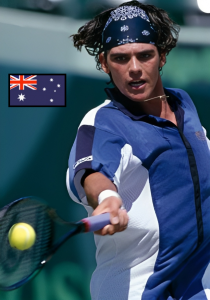 quarterfinal stage in his home tournament. In 1999 he was perceived, perhaps for the only time in his career, as one of the favorites, given that in his previous major, the US Open ’98, he had reached the final.
quarterfinal stage in his home tournament. In 1999 he was perceived, perhaps for the only time in his career, as one of the favorites, given that in his previous major, the US Open ’98, he had reached the final.
Philippoussis’ second major final came in a rather unexpected period, when he was struggling with injuries and had dropped in the ATP rankings to No. 48. As in his previous best Slam run, he survived an intense quarterfinal: at the US Open ’98 against Thomas Johansson, and at Wimbledon ’03 against Alexander Popp.
The tall Australian first made an impact in 1995 as a 19-year-old. In just his fifth ATP event, Philippoussis [272] reached the final in Scottsdale as a qualifier, defeating four much higher-ranked opponents before playing a competitive match in the final against former No. 1 Jim Courier. He then received a wild card for Key Biscayne and reached the third round. Those two results, along with a final in Bologna, catapulted him from outside the Top 300 into the Top 100 within a few months.
His serve was tremendous – never before had a teenager served with such intensity. In Kuala Lumpur later that year he set a record for the number of aces in a three-set match (unbeaten for twenty years), hitting 44 against Byron Black. He took serving to a new level, surpassing even Goran Ivanišević, who at that time had not yet reached 40 aces in five-set matches. Brad Gilbert, then coach of Andre Agassi, predicted that the future would belong to Philippoussis. His serve was phenomenal, his volleys technically sound, and his ground-strokes powerful yet inconsistent. It seemed like the full package.
At the 1996 Australian Open, aged 20, Philippoussis produced one of the best matches of his career in a night session, backing up Gilbert’s claims. In a battle of Greek descendants, he stunned the main favorite Pete Sampras in straight sets, only to follow it with a disastrous 2-6, 2-6, 2-6 loss to Mark Woodforde. Later that year he captured his maiden title in quite peculiar circumstances winning all matches in deciding sets (Toulouse); expectations were high, yet in 1997 he didn’t finish the season even in the Top 10 while the Top 5 seemed within his reach as he had won titles on three different surfaces that year (hard, clay, grass). He was somehow unable to showcase his full potential in the biggest tournaments. Enough said that prior the US Open ’98 semifinal, he hadn’t played a semifinal even at the Mercedes Super 9 level.
Without two Davis Cup-clinching victories (1999 and 2003), Philippoussis could be seen as an underachiever, as he had the tools to win at least one major. He was a novelty in the second half of the 90s with his uncompromising style and willingness to take risks like no one before him – often serving second serves around 200 kph regardless of the score or opponent, always believing that his destiny depended solely on his own game. “When I was on the court, I played. When I trained, I trained hard. But as soon as that thing was over, I switched off and enjoyed my life,” Philippoussis reflected years after retirement. Known for spending lavishly on fashionable cars and enjoying nightlife, he later admitted: “The greats have almost no life, and that’s the reality of it. They’re obsessed – you need to be obsessed with everything about what you’re doing.” Philippoussis’ second best major performance after the Aussie Open ’96 upset against Sampras, it’s arguably his five-set victory over Agassi at Wimbledon ’03. It’s rather weird that a man who was able to beat the two best players of the 90s at majors, never played at the season-ending championships (he was an alternate in Houston ’03).
Career record: 313–204 [ 204 events ]
Career titles: 11
Highest ranking: No. 8
Best GS results:
Wimbledon (runner-up 2003; quarterfinal 1998-2000)
US Open (runner-up 1998)
Davis Cup champion 1999 & 2003 (won clinchers on both occasions)
Born: August 13, 1976 in Guayaquil (Guayas)
Height: 1.87 m
Plays: Right-handed (two-handed backhand)
There is one particular thing about Lapentti – his extraordinary ability to close out matches once he had created a match point. I am not aware of any other player at the main-tour level with such a remarkable ratio of wins from match point down compared to losses after squandering one. His career record in these situations stands at 16-2 across fifteen years.
The first of those two defeats came at Key Biscayne 1998, where he lost to Slava Doseděl 6-3, 6-7, 4-6 despite holding six match points. Two months later in Prague, he lost to Doseděl again 6-3, 3-6, 2-6 after leading 3:1 in the second set. Later 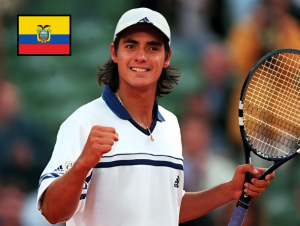 that year in Cincinnati, he was beaten by Scott Draper 4-6, 6-4, 5-7, having squandered one match point. Remarkably, from that point until the end of his career twelve years later, Lapentti won every match in which he reached match point – with one exception outside the main tour: the 2006 Montevideo Challenger, where Guillermo Cañas saved a match point and prevailed.
that year in Cincinnati, he was beaten by Scott Draper 4-6, 6-4, 5-7, having squandered one match point. Remarkably, from that point until the end of his career twelve years later, Lapentti won every match in which he reached match point – with one exception outside the main tour: the 2006 Montevideo Challenger, where Guillermo Cañas saved a match point and prevailed.
His resilience in seemingly hopeless situations bordered on the magical. There were occasions when defeat appeared inevitable, yet he found a way to win. Two examples stand out from 2003: in St. Pölten, he squandered a match point at 5:4 in the third set against Irakli Labadze, then trailed 2:6 in the deciding tie-break before surviving 5-7, 7-6, 7-6. Weeks later at Wimbledon, he let slip a double match point in the third set against Jamie Delgado, then saved one match point at 3:5 in the fifth set and three more as a receiver in the next game, eventually taking the decider 7-5.
Like Wayne Ferreira, Lapentti had won five-setters in all possible close-call situations from a break down: being just a game or two from a straight-sets defeat, to nearly losing in the fourth set, to being on the verge of defeat in the fifth – a feat not many players can boast over hundreds of professional matches.
This was not always the case early in his career, as shown by his 6-8 fifth-set Davis Cup losses to Daniel Nestor and Marcelo Ríos. But at the 1999 Australian Open he rewrote the pattern, defeating Karol Kučera 8-6 in the fifth set after intentionally dropping the fourth from 3:0 down. That victory took him to the only Grand Slam semifinal of his career, and from then on he won seven of his next ten matches when the deciding set reached 5-all.
He belongs to the select group of players who have won at least 30 five-setters. Yet it would be wrong to assume he almost always prevailed in close contests. Lapentti lost plenty of tight matches of all kinds – his “magic” seemed to work specifically once he had a match point in hand.
Lapentti was a smart, all-round player. He lacked a definitive finishing stroke on either wing, did not possess a huge serve or outstanding volleys, but every shot in his arsenal was solid and adaptable. His on-court intelligence allowed him to read the match as it unfolded and choose the right shots at the right moments. That tactical awareness, combined with a measure of luck, went a long way toward explaining his success in dramatic matches. In his best ’99 season he claimed two ATP shields (Indianapolis – his biggest title, and Lyon) being on verge to be beaten there. Between those two events he survived one of the longest no-tie-break 3rd set in history, overcoming Fernando Meligeni in München. No doubt that among players born in the 70s Todd Martin is the best without a big title, I’d indicate Lapentti as a second/third best (pondering between him and Nicolas Kiefer) given his potential overall. As opposed to Martin, Lapentti never played a Mercedes Super 9/Masters 1K final, but during his prime the draws weren’t favorable, and he was eliminated in the latter stages either by the greatest players of his time (Miami ’00, Indian Wells ’01) or by the best player on a specific surface (Rome ’01).
The nephew of 1990 Roland Garros champion Andrés Gómez, Lapentti was most comfortable on clay, though he never advanced beyond the fourth round in Paris – losing on that occasion to his friend and former junior doubles partner Gustavo Kuerten. In 1994, Lapentti defeated Kuerten in the Orange Bowl singles final, and together they reached the doubles final.
When Lapentti’s younger brother Giovanni Lapentti (b. 1983) arrived on the tour, Nicolás publicly described him as the more talented of the two. That prediction never materialised, as Giovanni failed to win a match at Grand Slam level and remained stuck on the Challenger circuit.
Trivia: Lapentti is one of just four players in the Open Era to win his first ATP-level title in his debut event — Bogotá 1995 (others: Yahiya Doumbia, José Francisco Altur, Santiago Ventura) capitalizing on the extreme conditions at 2,640 m above sea level, having trained at similar altitude in his native Quito.
Career record: 317–287 [ 287 events ]
Career titles: 5
Highest ranking: No. 6
Best GS results:
Australian Open (semifinal 1999)
Wimbledon (quarterfinal 2002)
Born: December 17, 1977 in Aix-en-Provence (Alpes-Côte d’Azur)
Height: 1.72 m
Plays: Right-handed (two-handed backhand)
He is a good example of how a bit of luck and a few good events, even without spectacular successes, can shift a player from one level to another. In autumn 1997, the almost 20-year-old Clément, one of many young French “Challenger” players, lost in qualifying at Toulouse but entered the main draw as a lucky loser and beat Magnus Larsson [25] in the second round. That result helped him build self-confidence. In two more main-level appearances (Vienna and Lyon), Clément made shocking upsets, eliminating Top 10 players Sergi Bruguera and Patrick Rafter in the first round. From a 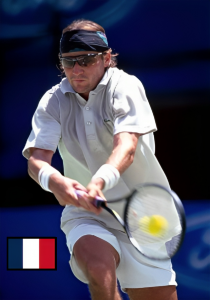 player on the verge of the Top 200, he suddenly became a Top 100 contender. The Paris-Bercy organisers rewarded him with a Centre Court slot, and he seized the opportunity, defeating another much higher-ranked opponent, Marc Rosset, in a match that gave him his first real exposure to a worldwide audience. It was already clear that the short Frenchman – blessed with a very good serve for his height and aggressive baseline strokes – would be capable of doing some damage in the future.
player on the verge of the Top 200, he suddenly became a Top 100 contender. The Paris-Bercy organisers rewarded him with a Centre Court slot, and he seized the opportunity, defeating another much higher-ranked opponent, Marc Rosset, in a match that gave him his first real exposure to a worldwide audience. It was already clear that the short Frenchman – blessed with a very good serve for his height and aggressive baseline strokes – would be capable of doing some damage in the future.
Clément proved it three years later in Melbourne. In retrospect, his run to the 2001 Australian Open final is even more admirable: apart from beating Greg Rusedski, Yevgeny Kafelnikov, and his friend Sébastien Grosjean in a dramatic semifinal (saving match points in the third set), he had also defeated in straight sets two teenagers who would later become top players – Tommy Robredo and… Roger Federer. After that match Clément led Federer 3:1 in their Head-to-Head, though it would end 3-8.
For a player with only four small ATP titles (Lyon 2000 arguably his finest) in eleven finals, he still delivered strong results at the biggest events. In addition to his sensational run to the Australian Open final, he reached the Cincinnati semifinal and two other major quarterfinals. The second of these came at the twilight of his career, when he narrowly lost to Rainer Schüttler in a five-set marathon.
Throughout his career, Clément wore medically prescribed sunglasses. When France claimed the 2001 Davis Cup title, he was not on the team for the final but had been instrumental earlier in the year in ties against Belgium, Switzerland, and the Netherlands. He nearly ousted Andre Agassi in the second round of Roland Garros 1999 before the American went on to win the title. One year later, he stunned Agassi – then the defending champion – in the second round of the US Open. Clément never faced Pete Sampras, but his wins over Agassi, a young Federer, and Rafael Nadal (Marseille 2006) remain points of pride.
Despite his modest height, Clément could hold serve for long stretches, which helped him in two epic five-setters. The first he won, 15-13 in the fifth against Rosset in Davis Cup; the second he lost, 14-16 in the fifth to Fabrice Santoro. The latter, completed at Roland Garros 2004, lasted 6 hours 35 minutes and was the longest match in the Open Era until the Isner–Mahut extraordinary epic six years later. “What do I get? A medal? I’m not interested,” said a clearly distraught Clément afterwards. “Anyway, it lasted over two days, so it doesn’t count.” It counted officially…
Career record: 316–327 [ 319 events ]
Career titles: 4
Highest ranking: No. 10
Best GS results:
Australian Open (runner-up 2001)
Wimbledon (quarterfinal 2008)
US Open (quarterfinal 2000)
Davis Cup champion 2001 (didn’t play in the final)
Born: December 9, 1978 in Temperley (Buenos Aires)
Height: 1.76 m
Plays: Right-handed
Gaudio’s unexpected triumph at Roland Garros 2004 gave me thrills – perhaps the most intense emotions I’ve ever felt watching tennis – especially in the fifth set of his epic drama against Guillermo Coria. Even though Gaudio entered the event ranked No. 44 and had never played a major quarterfinal (nor would he ever again), I had listed him among a few main contenders for the title on my temporary website. When he converted match point against Coria, it felt like an 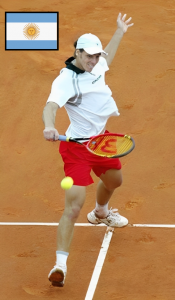 astonishing personal prediction coming true.
astonishing personal prediction coming true.
My belief in him stemmed from his previous battles in Paris against the best clay-courters of the early 2000s: in 2002 (fourth round) he lost to Juan Carlos Ferrero 7-6, 1-6, 7-6, 2-6, 4-6; the following year (third round) to Gustavo Kuerten 6-7, 5-7, 7-5, 3-6. Both matches were tight and could have gone the other way had Gaudio been mentally more stable – the clay-court tennis displayed there was of the highest quality, his offensive one-handed backhand second to none. My reasoning was: <<if he handles pressure in the decisive moments better, he may win the whole thing.>>
The 2004 French Open context was unusual – both Ferrero and Kuerten were far from their title-winning form, and a teenage Rafael Nadal withdrew (it’s debatable how far he could have gone in 2004, but worth noting that Gaudio comfortably led Nadal 3-0 in their H2H before losing at Monte Carlo 2005; Nadal would win their last three encounters, including the Stuttgart final). The draw was wide open, with Coria as the clear favorite — and he fully lived up to it for most of the fortnight.
In the memorable final, Coria led 6-0, 6-3, 4:3* when something extraordinary happened — the crowd began cheering for Gaudio with a “Mexican wave,” shifting the atmosphere entirely. Coria began to cramp, and suddenly Gaudio, who had been trying merely to avoid humiliation, looked almost paralyzed in front of a wide-open door. According to my stats, in his 119 main-level events before Roland Garros 2004, he had won just once when facing a match point. Against Coria, he saved two match points (both on return!) and ultimately survived the 3-hour 31-minute battle, sealing victory with his trademark cross-court backhand.
Before Paris 2004, Gaudio’s five-set record was a miserable 1-9 (the most painful loss coming in the Davis Cup 2002 semifinal against Russia). During those two magical weeks in Paris, he won three five-setters — including the first two rounds against strong opponents.
Gaudio is often labeled a one-Slam wonder, yet in the aftermath of that triumph he established himself as a Top 10 player for two years, reaching two big semifinals — once at Masters ’05 saving match points against Fernando González before being demolished by Roger Federer, the second big semifinal comes from Monte Carlo ’06. He finally began doing what many had expected from him years earlier: winning tight matches more consistently, which allowed him to reach clay-court finals regularly (in 2005 he won four successive finals, arguably the most satisfactory at Viña del Mar where he defeated three seeded players in a row.
In total, Gaudio played sixteen ATP finals in his career (all on clay), with a record of 8-8… 2:4 before Paris 2004 and 6:4 afterwards, coming close to a seventh title in Båstad. Given his three Masters 1K quarterfinals outside clay, it’s rather surprising that he didn’t reach a hardcourt final, with his style he wasn’t a threat on grass and carpet at all. His form declined sharply at 27, which was common among several Argentine players of his era. At 29, he played his last full season, losing even in Challengers to much weaker opponents.
Though he faded from the scene, Gaudio’s sensational triumph in Paris 21 years ago made him “immortal” – he remains the only Grand Slam champion never to reach a quarterfinal at any other major before or after his victory.
Career record: 270–196 [ 194 events ]
Career titles: 8
Highest ranking: No. 5
Best GS result:
Roland Garros (champion 2004)
Born: May 29, 1965 in Madrid
Height: 1.80 m
Plays: Right-handed
It’s difficult to explain why the older brother Emilio achieved much more than the younger Javier Sánchez (b. 1968 in Pamplona, the best junior of 1986). Unlike the McEnroe brothers, who had completely different personalities and game styles – and a larger age gap (John was seven years older than Patrick), placing them in different tennis eras (John was a transitional player between wooden and steel/aluminium racquets) – the Sanchez brothers played at the same time, facing the same opponents. Their 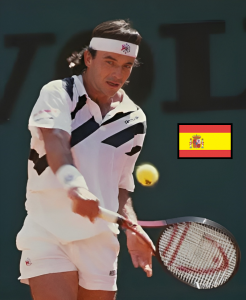 game styles were almost identical and suited to what, in the 1980s, could be described as the “Spanish school” – one-handed backhands, plenty of slices, clay as their natural habitat, and solid overall technique that allowed them to apply serve-and-volley tactics when needed.
game styles were almost identical and suited to what, in the 1980s, could be described as the “Spanish school” – one-handed backhands, plenty of slices, clay as their natural habitat, and solid overall technique that allowed them to apply serve-and-volley tactics when needed.
Emilio had something indefinable – something that helped him beat players who were, on paper, superior. He defeated Ivan Lendl, Boris Becker, and Stefan Edberg – the best players during his prime – while Javier lost to all of them in every encounter. A curiosity about Javier: he lost to Edberg twice with the same scoreline (6-2, 6-7, 2-6); first in Stuttgart ’92, where he blew two match points, and a year later in Monte Carlo, being two points from victory again.
Javier may have envied his older brother – he copied him in everything – yet it wasn’t enough to match his ranking or win a title of the same caliber (Emilio’s biggest title was Rome ’91). At least when it came to Grand Slams, they were on equal footing – two quarterfinals each. Surprisingly, both of Javier’s Slam quarterfinals came in New York (1991 and 1996), rather than Paris, which seemed more likely given his style. Emilio, in both of his major quarterfinals (1988), was stopped by Mats Wilander – then the best player in the world – after almost identical matches: 7-6, 6-7, 3-6, 4-6 in Paris, and in New York City 6-3, 6-7, 0-6, 4-6, blowing set points in both matches to lead two sets to love. Interestingly, these matches followed a pattern they’d already established at Wimbledon in 1987, when Wilander prevailed 2-6, 7-6, 6-3, 7-5.
Emilio first showed he was a serious force on clay courts at Rome 1986, reaching the final and playing a competitive match against the world’s best, Lendl. Two years later, he proved himself dangerous on hard courts too, reaching the final at Indian Wells. The years 1990-91 were the peak of his career. He began that stretch by winning the Hopman Cup for Spain alongside his sister Arantxa Sanchez, including a dramatic win over John McEnroe (who have beaten Emilio in two tight five-setters in Slam fourth rounds).
Before claiming the biggest title of his career in Rome, Emilio had already captured one of the most important titles for any Spanish player – Barcelona – defeating compatriot Sergi Bruguera. Had Sanchez and Bruguera both played their best tennis at the same time, they could have led Spain to a Davis Cup final. That never happened, though, as Bruguera’s rise coincided with Sanchez’s decline. Still, they did help Spain win the World Team Cup in 1992, with Sanchez winning all four of his singles matches – three of them from the brink of defeat, and all against top opponents.
Later that year, Sanchez and Bruguera met in the Palermo final, marking the beginning of the end for Sanchez, who from then on started losing more regularly. One more noteworthy result followed: a semifinal in Hamburg, where he nearly beat local favorite Michael Stich.
Sanchez remains one of the most successful doubles players ever to reach the Top 10 in singles. He won 50 doubles titles (including three Slams), the vast majority of them with Sergio Casal. The duo also won a silver medal at the Seoul Olympics. Many years after retiring from professional tennis, he returned to the circuit as Spain’s Davis Cup captain and led the team to victory in 2008, capturing the prestigious trophy despite the absence of Rafael Nadal in the final.
Career record: 431–291 [ 287 events ]
Career titles: 15
Highest ranking: No. 7
Best GS results:
Roland Garros (quarterfinal 1988)
US Open (quarterfinal 1988)
World Team Cup 1992 champion
Hopman Cup 1990 champion
Born: May 30, 1976 in Filipstad (Värmland)
Height: 1.88 m
Plays: Right-handed (two-handed backhand)
Norman, born into a family of professional athletes, was seen as a potential successor to Sweden’s greatest players. Already as a 16-year-old – before even entering junior tournaments – he received a wild card for Stockholm qualifying and, despite being unranked, defeated three players, including Peter Lundgren, a former world no. 25 who was eleven years older. Although Norman was thrashed in the first round by Derrick Rostagno, the ATP debut was exceptionally promising.
The next two years were tough: Norman competed in Satellites and Challengers, with almost three years separating his 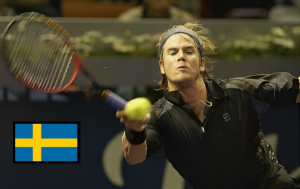 first two ATP appearances. Even though he didn’t establish himself as another Björn Borg, Mats Wilander, Stefan Edberg, or even Thomas Enqvist, he gained recognition in the late 1990s as a dangerous floater. His breakthrough came at Roland Garros 1997, where he advanced to the quarterfinal having ousted Pete Sampras in the third round – still a huge result at the time, even if Sampras was already past his clay peak. In the French Open – Wimbledon stretch of 1997, Norman showed great mental toughness, winning epic five-setters against the two fastest left-handed servers on tour: 9-7 in the 5th against Greg Rusedski in Paris, and 14-12 in the 5th versus Goran Ivanišević at Wimbledon (saving four mini–match points at 11-all). In that latter match, Norman began experiencing heart problems, and in December 1997 he underwent a five-hour surgery to correct an irregular heart rate.
first two ATP appearances. Even though he didn’t establish himself as another Björn Borg, Mats Wilander, Stefan Edberg, or even Thomas Enqvist, he gained recognition in the late 1990s as a dangerous floater. His breakthrough came at Roland Garros 1997, where he advanced to the quarterfinal having ousted Pete Sampras in the third round – still a huge result at the time, even if Sampras was already past his clay peak. In the French Open – Wimbledon stretch of 1997, Norman showed great mental toughness, winning epic five-setters against the two fastest left-handed servers on tour: 9-7 in the 5th against Greg Rusedski in Paris, and 14-12 in the 5th versus Goran Ivanišević at Wimbledon (saving four mini–match points at 11-all). In that latter match, Norman began experiencing heart problems, and in December 1997 he underwent a five-hour surgery to correct an irregular heart rate.
The surgery delayed his rise, and he slumped during 1998 – though he did contribute significantly to Sweden’s Davis Cup title. In the first round he won a 4th rubber against Karol Kučera in five sets when Sweden was a few games from being eliminated, and opened the final against Italy with a thrilling win over Andrea Gaudenzi in extremely lucky & dramatic circumstances. That Davis Cup success launched the most successful stretch of Norman’s career.
In 1999, he won five ATP titles (Orlando, Stuttgart, Umag, Long Island, Shanghai), that year as many as the two greatest players of the 90s, though underwhelming results at the majors kept him out of the Top 10. The following year, 2000, was the peak of his career. With Sampras and Andre Agassi nearing the end of their rivalry, Norman briefly emerged as a contender for the world no. 1 ranking, having defeated young players who seemed to be potential rulers of the 2000s, in Melbourne & Paris. He didn’t have any weapon that would allow him to win matches, his movement was rather clumsy, but he had a strong serve and solid flat shots from both wings, using them wisely, moreover he was super clutch at tight situations during his two excellent seasons. He admitted that since his junior days he had kept a journal in which he wrote down which specific shots work against particular players… In the spring of that most fruitful year, he reached the final stages of three biggest clay-court tournaments, facing Gustavo Kuerten in all three: he beat Kuerten in the Roman final, lost in the Hamburg quarterfinals, and then played an unforgettable final in Paris.
That Roland Garros match is arguably the most dramatic four-set Slam final ever. Norman won the third set and saved 10 match points in the fourth before finally losing it. The quality of play and emotional intensity were extraordinary. During the trophy ceremony, Norman visibly blinked uncontrollably, suggesting he was still overwhelmed by nerves. It’s possible that this match – more than any other – determined that Kuerten, not Norman, ended the year ranked no. 1.
From there, Norman’s career entered a slow decline. Though still dangerous in 2001-02, he never recaptured the aura he had in 1999-00, not being able to get another title. In 2003, his career collapsed. Battling knee and hip issues that had required surgery, still worried about his heart, he lost ten consecutive matches (excluding qualifying), including a 1-6, 3-6 defeat to Greek journeyman Konstantinos Economidis. His four-hour first-round loss at the 2003 US Open to Jean-René Lisnard was particularly painful: after escaping a straight-set loss and holding a match point at *5:3 in the 5th, he lost the set 6-7. Prior to that blow, for a long time he was always winning while serving for the match. Norman entered just two more events after that disaster before announcing his premature retirement.
After hanging up his racquet, Norman built a new career as one of the most respected coaches on tour. He helped Robin Söderling reach two French Open finals and later guided Stan Wawrinka from a Top 20 player without any significant titles into a multiple Grand Slam champion.
Career record: 244–177 [ 174 events ]
Career titles: 12
Highest ranking: No. 2
Best GS results:
Australian Open (semifinal 2000)
Roland Garros (runner-up 2000; quarterfinal 1997)
Davis Cup 1998 champion
Born: June 20, 1969 in Glen Cove (New York)
Height: 1.80 m
Plays: Right-handed (two-handed backhand)
Some sort of a late bloomer, Washington belonged to a generation in which players who achieved similar results typically entered the Top 100 already as teenagers. Washington, however, spent two years studying at the University of Michigan, and became a stable Top 100 player just as he was turning 22. After reaching a few semifinals on American soil, he played two dramatic five-setters in 1991, at Roland Garros and Wimbledon – losing to top players Guy Forget and Ivan Lendl respectively – which boosted his self-confidence. At the beginning of 1992, he triumphed in Memphis without dropping a 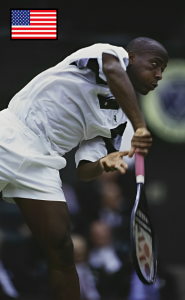 set. That title, won in Tennessee, remained the biggest of his résumé. A few months later, after defeating Henri Leconte in the third round of the US Open, marking his Centre Court debut at Slams, Washington was one set away from cracking the Top 10 but eventually lost in five sets to Michael Chang – and would ultimately never enter the Top 10, even though better results still lay ahead.
set. That title, won in Tennessee, remained the biggest of his résumé. A few months later, after defeating Henri Leconte in the third round of the US Open, marking his Centre Court debut at Slams, Washington was one set away from cracking the Top 10 but eventually lost in five sets to Michael Chang – and would ultimately never enter the Top 10, even though better results still lay ahead.
In 1992 he was considered one of the revelations of the season, alongside two younger players, Wayne Ferreira and Richard Krajicek – both of whom would enjoy more successful careers. Still, the years 1992-1996 were fruitful in Washington’s case. He would likely have been seeded at the majority of majors had 32 seeds existed at the time. His three best results from those years were three finals at big events: Key Biscayne ’93, Essen ’95 (where he defeated an almost unbeatable Andre Agassi in round three), and Wimbledon ’96. The latter was especially remarkable: just before the final – lost to Krajicek in what was arguably the most unexpected major final of the 1990s – Washington survived incredibly dramatic matches. He broke Alex Radulescu’s serve for the first time in the final game of their five-setter, and in the semifinal against Todd Martin, he came back from 5:1* down in the deciding set. “Ultimately in tennis, you want that elusive major – and I was in the finals of the biggest one of them all,” said Washington. “I had 13 great days at Wimbledon that year, but Richard had 14. I loved playing at Wimbledon and reaching the final. But my goal was to win the title.”
A Davis Cup rubber in 1997 against a then-unknown Gustavo Kuerten marked the beginning of Washington’s decline. The 28-year-old American [24] defeated Kuerten in four sets (3-6, 7-6, 7-6, 6-3) on clay in Brazil, in front of a hostile crowd, playing perhaps his best match on that surface – a win that became more valuable when Kuerten went on to win Roland Garros a few months later. But during the third set tie-break, Washington injured his left knee. He underwent surgery in Jacksonville on April 30 and played only two more Grand Slam tournaments before retiring in November 1999.
In 1998, he returned to the tour using a protected ranking but was far from his former level. Late that year, he entered two Challengers and lost in the first round of both. In 1999, he played just two events before ending his career. His five-years-younger brother, Mashiska Washington, also joined the men’s professional tour, but won only two main-level matches and reached a career-high ranking of No. 290. Mal didn’t possess a single dominant stroke, yet he also had no glaring weakness. His smooth court movement allowed him to adapt to different opponents and surfaces; however, patience was not his strongest trait, and he never managed a notable result on European clay (he didn’t bother to make a trip to Monte Carlo even once).
Career record: 254–184 [ 186 events ]
Career titles: 4
Highest ranking: No. 11
Best GS results:
Australian Open (quarterfinal 1994)
Wimbledon (runner-up 1996)
Born: April 25, 1976 in Korbach (Heßen)
Height: 1.79 m
Plays: Right-handed (two-handed backhand)
Schüttler had four match points (7-6, 2-6, 6-8) in the third round of the 1994 Australian Open juniors against local favorite Mark Philippoussis, but during his early professional years, it would have been difficult to imagine him coming within a point of a Grand Slam quarterfinal – he was losing in the first round of qualifying events at majors. That changed dramatically in Doha 1999: Schüttler not only claimed his first ATP title as a qualifier, but also defeated three Top 20 players in 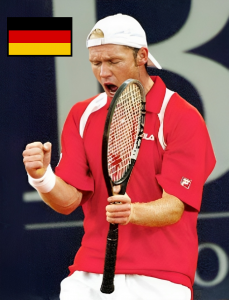 succession. That success allowed him to bypass qualifiers and play directly in ATP tournaments after a three-year struggle collecting points on the Challenger circuit.
succession. That success allowed him to bypass qualifiers and play directly in ATP tournaments after a three-year struggle collecting points on the Challenger circuit.
The 2003 Australian Open defines Schüttler’s status in tennis history. The German unexpectedly reached the final where he was severely beaten by Andre Agassi, whom the German called “the toughest opponent he ever played against” – the shocking success was slightly allowed by Marat Safin’s withdrawal in the third round – but calling him a fluke finalist would be unfair. He beat David Nalbandian (QF) and Andy Roddick (SF) in back-to-back matches.
“During the two weeks, I didn’t think too much,” Schüttler recalled. “I was playing match-by-match, I was trying to go on court and play as well as I can. One memory that stands out is when I won a match point in the semi-finals against Roddick. I felt how cleanly I hit the backhand down the line to win the match. It was unbelievable during the night session, the stadium was full. The spectators were on their feet for a standing ovation.” Schüttler’s backhand down the line may be considered as his best shot.
He primarily based his game on excellent physical fitness, being a typical grinder with a never-say-die attitude, yet he didn’t like to operate far behind the baseline during rallies. Following his sensational run in Melbourne, Schüttler maintained high-level form for over a year, reaching semifinals in top tier events (Indian Wells, Montreal, Cincinnati, Houston), capturing back-to-back titles on two surfaces (Tokyo and Lyon), and contesting another big final on his least favorite surface – clay, Monte Carlo (2004). But after that tournament, at age 28, he began struggling to win three consecutive matches, it lasted several years but he remained patient still believing in a miracle which ultimately happened in 2008…
He announced his retirement in October 2012, having played his last pro matches (five in qualifying rounds in Qatar & Australia) ten months earlier: “I played my last match in January and due to a groin injury and fitness problems I have decided to retire. I would have liked to have played in the London Olympics at Wimbledon this summer, but I will now concentrate on future projects.”
Besides the Australian Open final, Schüttler had two other career highlights in his long 17-year journey: the Olympic doubles final in 2004, where he and Nicolas Kiefer squandered four match points, and the Wimbledon 2008 semifinal. That year, he seemed finished – ranked No. 94, aged 32, and enduring the longest main-level losing streak of the season (8) – but his risk-taking style paid off in the fortnight. He won five matches, including a quarterfinal marathon over Arnaud Clément in which he saved a match point – one of a few Wimbledon matches that lasted more than five hours.
Trivia: Schüttler was bagelled twice in his career: first in Tokyo 1998 by Jan-Michael Gambill, then at the 2009 World Team Cup by Robin Söderling. A few days after the Söderling humiliation, he suffered a brutal first-round loss at Roland Garros: 0-6, 0-6, 4-6 to Marc Gicquel. Yet, astonishingly, after that clay-court slump, he switched to grass and nearly reached the final in the Netherlands, losing to Benjamin Becker – the man who had ended Agassi’s career at the 2006 US Open. As a player born in the mid-1970s, the German experienced two distinct eras of tennis and managed to defeat all the greatest players of his time except Pete Sampras – though they met only twice.
Career record: 327–337 [ 329 events ]
Career titles: 4
Highest ranking: No. 5
Best GS results:
Australian Open (runner-up 2003)
Wimbledon (semifinal 2008)
Born: September 17, 1985 in Valašské Meziříčí (Zlínský kraj in Czechoslovakia)
Height: 1.96 m
Plays: Right-handed (double-handed backhand)
Stan Wawrinka achieved more or less what I expected from Berdych. Quite revealing is their Australian Open 2014 semifinal: Wawrinka beat Berdych in a tight four-setter (6-3, 6-7, 7-6, 7-6), winning just one more point in the entire contest. Then he outplayed an injured Rafael Nadal in the final and later collected two more major titles. Would Berdych have done the same if he had been more lucky in the tie-breaks against the Swiss? In my opinion, the Czech had all the ingredients not only to win a few majors, but also to become No. 1 in the world at some point in his career.
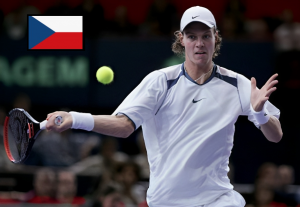 At the end of 2005, when Roger Federer and Nadal had already established themselves as tennis kings for the years to come, Berdych triumphed in Paris-Bercy, having defeated only top players – so it seemed that a bright future was ahead of him: big serve, effortless flat and quick strokes off both wings, with the ability to spread winning forehand shots in all directions regardless of court position, good volley technique, cool under pressure (after the US Open ’06 he held a stunning 9:0 record in five-setters). At the time he had already defeated both Federer and Nadal after tight matches (in Athens ’04 and Cincinnati ’05 respectively), as well as the third-best player of the mid-00s, Andy Roddick, in Tokyo ’08.
At the end of 2005, when Roger Federer and Nadal had already established themselves as tennis kings for the years to come, Berdych triumphed in Paris-Bercy, having defeated only top players – so it seemed that a bright future was ahead of him: big serve, effortless flat and quick strokes off both wings, with the ability to spread winning forehand shots in all directions regardless of court position, good volley technique, cool under pressure (after the US Open ’06 he held a stunning 9:0 record in five-setters). At the time he had already defeated both Federer and Nadal after tight matches (in Athens ’04 and Cincinnati ’05 respectively), as well as the third-best player of the mid-00s, Andy Roddick, in Tokyo ’08.
It’s really difficult to explain what happened to him in the next few years that he didn’t become at least a solid Top 5 player, multiple Masters 1K champion. The place which “should have been” his was taken by Novak Đoković and Andy Murray in the late 00s – even though Berdych was also able to defeat them after dramatic matches (Paris ’11, Rome ’13), as well as at Slams in straight-set contests.
He needed to play a lot to finally reach his first (and only) major final – Wimbledon 2010. In that final he easily lost an ugly match to Nadal. The Spaniard and the Serb turned out to be Berdych’s nightmarish opponents: he finished his career with two terrible H2H records: 4-20 (from 3:1!) and 3-25 respectively against them (barely avoided a double bagel in Beijing ’14). His inability to defeat Nadal and Đoković for many years is the main explanation why he didn’t win another Masters 1000 title (three finals: Miami ’10, Madrid ’12, Monte Carlo ’15) or reach another major final (five semifinals after Wimbledon ’10 – two of them lost to Murray in copycat semifinals: US Open ’12 and Australian Open ’15).
I’ve got two ideas why Berdych couldn’t manage it despite remaining a super consistent Top 10 player over seven years:
I… as a well-established Top 10 player, he reinvented himself as a “second Björn Borg” – always trying to be cool, no matter how badly things were going. In my opinion, he needed to show much more emotion to engage fully in psychological battles against guys like Nadal and Đoković.
II… over the years in Davis Cup ties, Berdych was very successful in doubles, especially alongside Radek Štěpánek. What’s really interesting is that Berdych collected an impressive 21-2 record, playing serve-and-volley on a regular basis. It’s beyond me why he didn’t use this attacking mindset more often in singles during big matches.
By the way, in 2013 Berdych, partnering Lukáš Rosol (b. 1985), won the longest doubles match in history: the Czechs defeated Wawrinka/Marco Chiudinelli of Switzerland 6-4, 5-7, 6-4, 6-7, 24-22 after 7 hours and 1 minute!
If I have to point out the biggest underachiever among the best players born in the 80s, I have no doubts – it’s Berdych. Admittedly, he made up for many disappointments with back-to-back Davis Cup titles (2012-13), but he couldn’t be truly fulfilled, because he didn’t win a clincher in those finals. He was even a slight favorite to beat David Ferrer in front of the home crowd on a fast indoor court… and lost in straights, the same the following year that time being an underdog though.
Trivia: from the beginning of his career to the end of 2014, he always played with a baseball cap – regardless of whether it was indoors or outdoors, and no matter the length of his hair (which was very long in his early years on tour). He ended his career in 2019 but announced his intent to perform at the Tokyo Olympics ’20. It was not granted to him due to the cancellation of the event by the COVID-19 pandemic.
Career record: 640-342 [ 330 events ]
Career titles: 13
Highest ranking: No. 4
Best GS results:
Australian Open (semifinal 2014-15; quarterfinal 2011-13, ’16)
Roland Garros (semifinal 2010; quarterfinal 2014, ’16)
Wimbledon (final 2010; semifinal 2016-17; quarterfinal 2007, ’13)
US Open (semifinal 2012; quarterfinal 2014)
Davis Cup champion 2012-13
(in both editions he contributed more than Štěpánek, but in both finals Berdych lost rubbers that
could have given Czechia the trophy)
Born: April 17, 1985 in Le Mans (Pays de la Loire)
Height: 1.88 m
Plays: Right-handed (two-handed backhand)
The son of a Congolese father, Didier, and French mother, Évelyne (née Rosier). He is an example of someone who entered the luxury tennis saloons out of nowhere, but it’d make sense if we dug deeper into his first steps on the tour… China 2004: the 19-year-old Tsonga, US Open junior champion of 2003, receives a wild card to play in Beijing and 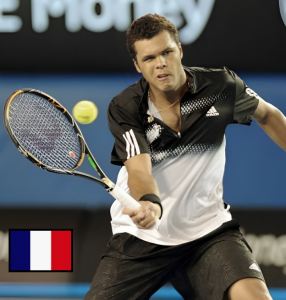 defeats No. 6 in the world Carlos Moyà 6-3, 6-3 in the first round! If someone who is unknown, ranked 209, eliminates a former best player in the world in his first main-level match, there must be something special about him.
defeats No. 6 in the world Carlos Moyà 6-3, 6-3 in the first round! If someone who is unknown, ranked 209, eliminates a former best player in the world in his first main-level match, there must be something special about him.
It’s confirmed more than three years later when Tsonga, participating in just his 16th main-level event, advances to the Australian Open final defeating i.a. Andy Murray & Rafael Nadal, showcasing phenomenal stop-volleys across three sets against the latter.
Between his sensational debut in Beijing and the career-biggest success in Melbourne, he struggled with many injuries (herniated disc & shoulder, moreover back and abdominal problems), because of that, instead of turning into a regular ATP player already in 2005, for two years he’d been drifting between Challengers & Futures events before making a Challenger-ATP transition in 2007, becoming a recognisable face at the beginning of the year in Melbourne, winning a record-tying tie-break vs Andy Roddick on Rod Laver Arena (the American won the match in four sets though).
Mats Wilander belonged to a big group of pundits delighted by Tsonga’s appearance at the Australian Open ’08; the Swede even said that Tsonga would be better than Roger Federer…
Relatively unknown players can hide their weaknesses and I think it was also Tsonga’s case during that amazing Australian fortnight. The following years exposed Tsonga’s backhand hole. Like Marc Rosset a decade earlier, Tsonga occasionally played backhand passing-shots using only one hand. I’d risk a thesis that Tsonga achieved more than you could expect from a guy with his unstable backhand, mainly thanks to his top-quality serve, very good mentality, affirmative attitude.
Tennis is such a psychological game; admittedly, it’s not boxing, you cannot punch your opponent (maybe Tsonga would be good at this with his nickname “Ali”, due to facial resemblance referring to the greatest boxer in history, Cassius Clay), but you can intimidate him, and this is what in my opinion Tsonga was doing very well throughout his career, especially in France (10 of his 18 titles come from French cities, four claimed in Franco-Germanic Metz), feeling the energy of the partisan crowd.
I suppose the vast majority of players knew that in crucial moments playing to his backhand was required, but only the best guys (Novak Đoković, Nadal, Murray) could do this often possessing the required skills. Đoković needed to figure it out – initially Tsonga was one of his toughest opponents, and the great Serb lost to him 5 out of the first 7 meetings including a five-setter at the Aussie Open ’10; their Wimbledon ’11 semifinal changed the history of their encounters and the Serb finished their rivalry at quite overwhelming 17-6. Similar story with Murray who was able to beat Tsonga eight straight times, also including a four-set Wimbledon semifinal – the Brit ultimately won their rivalry 14-2.
Other players were making many mistakes at tight moments or were playing too softly, allowing the Frenchman of African origin, running around his backhand to play big forehands, attack the net, and gain points with crispy volleys or eye-catching overheads; he was enjoying it in an expressive way, which can act as an intimidation factor, causing opponent’s stupid mistakes right after. At tight moments he was really able to raise his game not being afraid to implement the serve-and-volley tactics or accelerating his second serves. There’s no other player like Tsonga, who won three various extremes: the record tie-break (at least as far as majors are concerned, 20/18 against Roddick), the longest deciding 3rd set (25-23 against Milos Raonic), and one of the longest 5th sets in terms of games (19-17 against John Isner).
Tsonga for many years belonged to a group of the “second big 4” consisting of him, David Ferrer, Tomáš Berdych, and Juan Martín del Potro, but only Tsonga among them captured two Masters 1000 shields (Paris ’08 and Toronto ’14). Trivia: in 2011, Tsonga and Federer faced each other eight times – a record. Federer won six of those meetings, including the last one: the final of the “Masters”, yet the Frenchman emerged victorious from their five-set clash at Wimbledon. Tsonga’s career would have felt more fulfilled with a French Open final under his belt, but he fell short twice in the semifinals not facing a Big 4 member (2013, 2015), unable to bring his dream run all the way home in Paris.
Career record: 467–238 [ 244 events ]
Career titles: 18
Highest ranking: No. 5
Best GS results:
Australian Open (runner-up 2008; semifinal 2010; quarterfinal 2009, 13 & 17)
Roland Garros (semifinal 2013 & 15; quarterfinal 2012)
Wimbledon (semifinal 2011-12; quarterfinal 2010 & 16)
US Open (quarterfinal 2011, 15-16)
Davis Cup champion 2017











